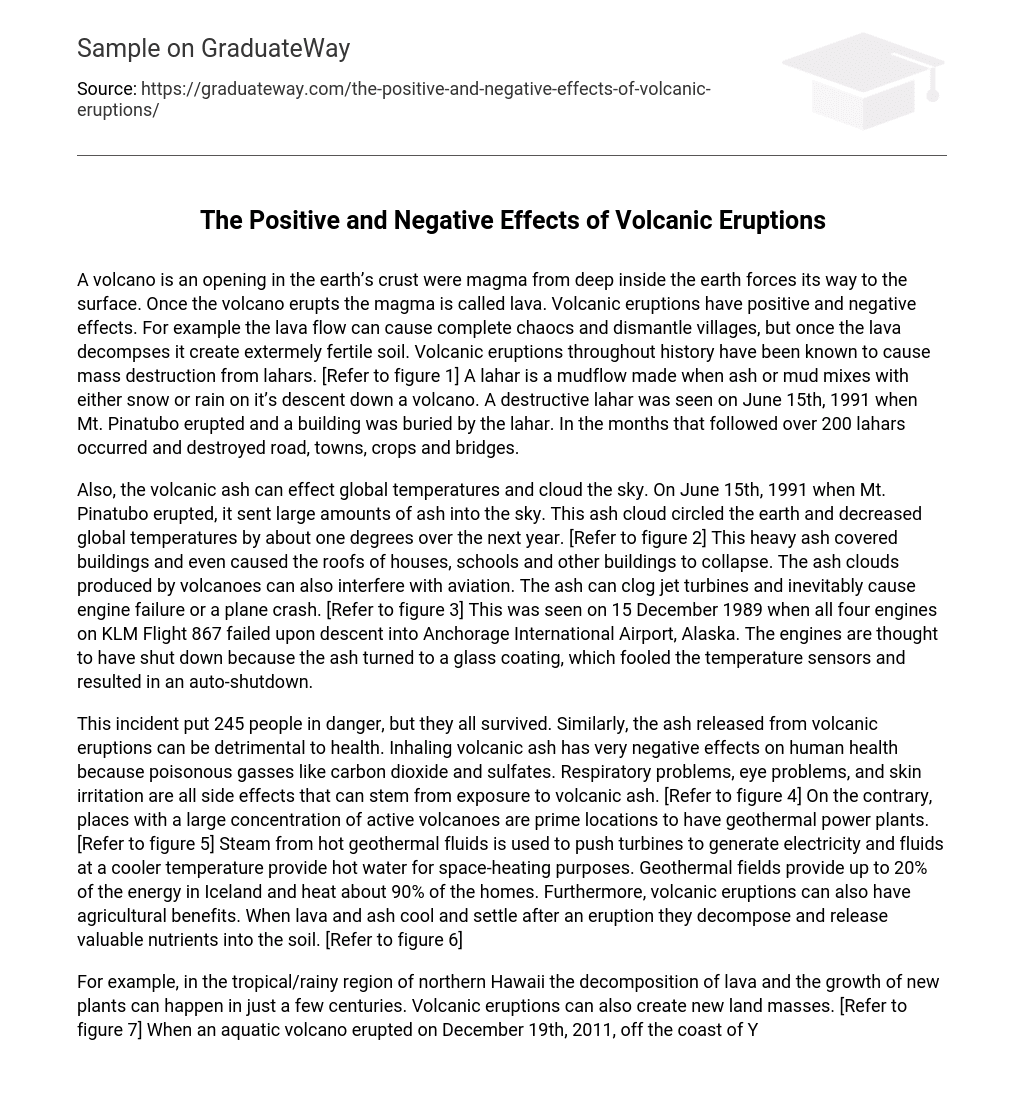A volcano is an opening in the earth’s crust were magma from deep inside the earth forces its way to the surface. Once the volcano erupts the magma is called lava. Volcanic eruptions have positive and negative effects. For example the lava flow can cause complete chaocs and dismantle villages, but once the lava decompses it create extermely fertile soil. Volcanic eruptions throughout history have been known to cause mass destruction from lahars. [Refer to figure 1] A lahar is a mudflow made when ash or mud mixes with either snow or rain on it’s descent down a volcano. A destructive lahar was seen on June 15th, 1991 when Mt. Pinatubo erupted and a building was buried by the lahar. In the months that followed over 200 lahars occurred and destroyed road, towns, crops and bridges.
Also, the volcanic ash can effect global temperatures and cloud the sky. On June 15th, 1991 when Mt. Pinatubo erupted, it sent large amounts of ash into the sky. This ash cloud circled the earth and decreased global temperatures by about one degrees over the next year. [Refer to figure 2] This heavy ash covered buildings and even caused the roofs of houses, schools and other buildings to collapse. The ash clouds produced by volcanoes can also interfere with aviation. The ash can clog jet turbines and inevitably cause engine failure or a plane crash. [Refer to figure 3] This was seen on 15 December 1989 when all four engines on KLM Flight 867 failed upon descent into Anchorage International Airport, Alaska. The engines are thought to have shut down because the ash turned to a glass coating, which fooled the temperature sensors and resulted in an auto-shutdown.
This incident put 245 people in danger, but they all survived. Similarly, the ash released from volcanic eruptions can be detrimental to health. Inhaling volcanic ash has very negative effects on human health because poisonous gasses like carbon dioxide and sulfates. Respiratory problems, eye problems, and skin irritation are all side effects that can stem from exposure to volcanic ash. [Refer to figure 4] On the contrary, places with a large concentration of active volcanoes are prime locations to have geothermal power plants. [Refer to figure 5] Steam from hot geothermal fluids is used to push turbines to generate electricity and fluids at a cooler temperature provide hot water for space-heating purposes. Geothermal fields provide up to 20% of the energy in Iceland and heat about 90% of the homes. Furthermore, volcanic eruptions can also have agricultural benefits. When lava and ash cool and settle after an eruption they decompose and release valuable nutrients into the soil. [Refer to figure 6]
For example, in the tropical/rainy region of northern Hawaii the decomposition of lava and the growth of new plants can happen in just a few centuries. Volcanic eruptions can also create new land masses. [Refer to figure 7] When an aquatic volcano erupted on December 19th, 2011, off the coast of Yemen, fishermen saw fountains gushing lava over 90 feet out of the water. A few days later NASA Earth Observatory released photos showing that this marine explosion created a new island. Lastly, volcanoes and volcanic activity makes a location more interesting to tourists. For example the underground geothermic fields of Iceland provide locals and tourist with exotic bathing pools. Additionally, the exciting scenery created by volcanoes can be a tourist attraction. Tourism can then supply revenue to and country and stimulate its economy. [Refer to figure 8] In conclusion, volcanoes are both beneficial to the environment and detrimental. When you balance out the positive effects like the use of geothermal energy against the negative repercussions, you realize that something good can be produced by the catastrophic eruptions.
Bibliography
Topinka, Lyn . “CVO Menu – The Plus Side of Volcanoes.” USGS Cascades Volcano Observatory (CVO). Version na. na, 13 July 2009. Web. 3 May 2013. . na, Deborah . ” Astonishing Volcanoes that Cause Death and Destruction.” Life in the Fast Lane: Art, the odd, the unusual, offbeat news, weird sciences, a little business, and yes, even trucking!. Version na. Life in the Fast Lane. , 27 June 2008. Web. 3 May 2013. . Buckland, Lucy. “An island is born: Amazing pictures show Red Sea underwater volcanic eruption creating new land.” Daily Mail. Version NA. Mail Online, 29 Dec. 2011. Web. 2 May 2013. . “KLM Flight 867 – Wikipedia, the free encyclopedia.” Wikipedia, the free encyclopedia. Version na. Wikipedia, the free encyclopedia, 26 Feb. 2013. Web. 3 May 2013.





